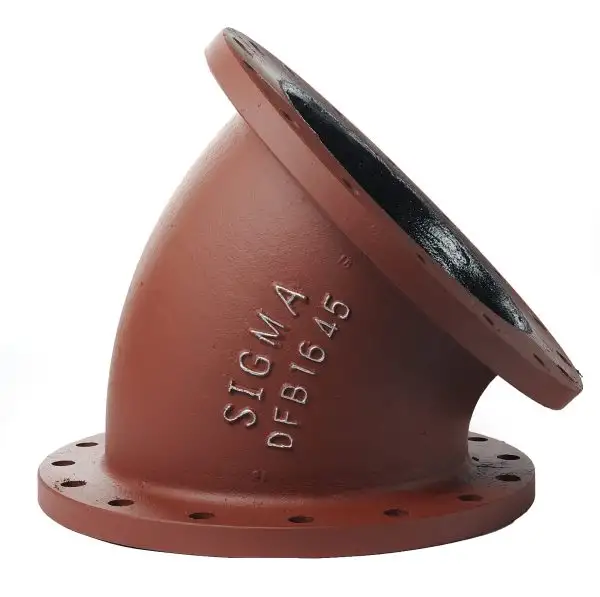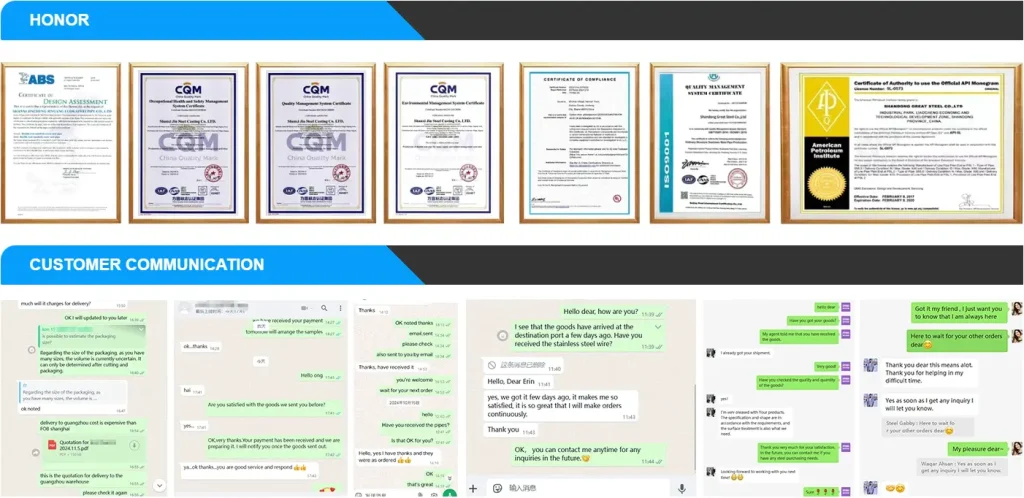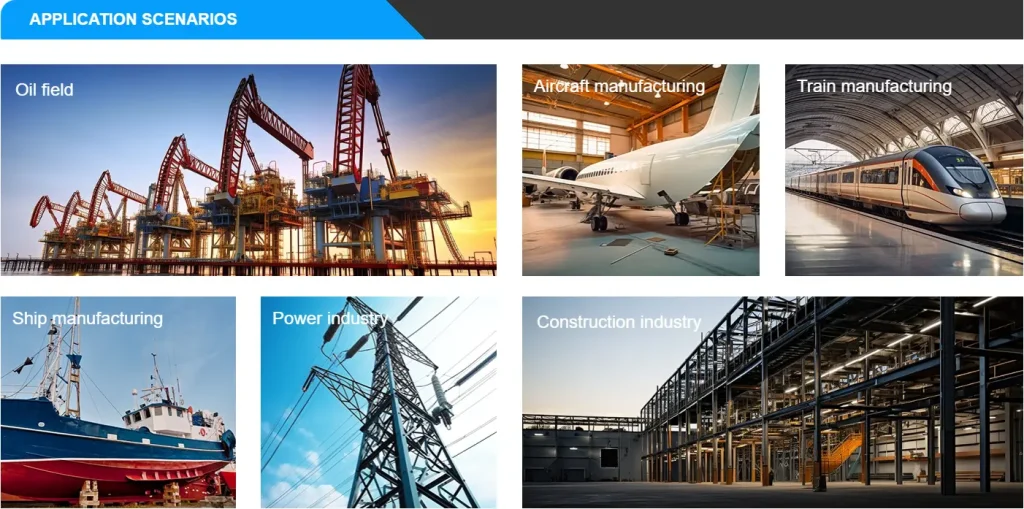We specialize in fittings that adhere to the stringent requirements of the American Water Works Association (AWWA) C110 standard. This standard, officially known as “ANSI/AWWA C110/A21.10, Ductile-Iron and Gray-Iron Fittings for Water,” sets forth the minimum requirements for ductile iron and gray iron fittings, typically ranging from 3 inches to 48 inches (76 mm to 1,219 mm), used in water applications.
Complete Specifications and Parameters
When specifying AWWA C110 ductile iron fittings, precision in understanding the parameters is crucial. We meticulously manufacture our fittings to comply with every aspect of this standard, ensuring seamless integration and optimal performance within your system.
|
Parameter |
Description |
Standard Requirements (AWWA C110) |
|
Material |
Ductile Iron Grade specified by the standard |
ASTM A536 Grade 60-42-10 or 65-45-12 (typically) |
|
Nominal Diameter (DN/NPS) |
Range of pipe sizes the fittings are designed for |
3 inches to 48 inches (DN 80 to DN 1200) |
|
Pressure Rating (PSI) |
Rated working pressure the fitting can withstand |
Flanged Fittings: 250 psi (1,724 kPa) for most sizes; 24-inch and smaller may be rated for 350 psi (2,413 kPa) with special gaskets. |
|
Joint Type |
Available connection methods for the fittings |
Flanged Joints: Faced and drilled to match ANSI B16.1 Class 125 flanges. |
|
Coating (Internal) |
Standard internal protective lining for water quality |
Cement-mortar lining per AWWA C104; Fusion Bonded Epoxy (FBE) or liquid epoxy also options per AWWA C116. |
|
Coating (External) |
Standard external protective coating for corrosion |
Asphaltic material/bituminous coating, or Fusion Bonded Epoxy (FBE) per AWWA C116. |
|
Dimensions (Laying Lengths) |
Specific center-to-end or end-to-end dimensions |
Defined in tables within AWWA C110 for various fitting types and sizes. |
|
Gasket Material |
Material for sealing joints |
Rubber gaskets (e.g., SBR, EPDM) conforming to AWWA C111/A21.11. |
|
Bolt & Nut Material |
Material for securing flanged or mechanical joints |
High-strength low-alloy steel (HSLA) with corrosion-resistant coatings (e.g., hot-dip galvanized, Dacromet). |
|
Minimum Wall Thickness |
Minimum acceptable thickness of the fitting body |
Specified by size and pressure class within AWWA C110. |
Comprehensive Performance Characteristics
We ensure our AWWA C110 ductile iron fittings offer exceptional performance, meeting the rigorous demands of water utility applications. Their design and material properties contribute to their outstanding longevity and reliability.
|
Performance Characteristic |
Description |
Typical Performance Data (AWWA C110 Compliance) |
|
Material Strength |
Adherence to ductile iron metallurgical properties |
Tensile Strength: Minimum 60,000 psi (414 MPa) or 65,000 psi (448 MPa). |
|
Ductility (Elongation) |
Ability to deform plasticially before fracture |
Minimum 10% or 12% elongation, depending on grade, providing flexibility. |
|
Hydrostatic Burst Strength |
Ability to withstand internal pressure without failure |
Fittings must withstand hydrostatic proof tests at pressures significantly higher than their rated working pressure (e.g., at least 3 times the rated working pressure). |
|
Corrosion Resistance |
Ability to resist chemical degradation from water and soil |
Enhanced by standard coatings (cement-mortar lining, FBE, bituminous paint) for extended service life. |
|
Impact Resistance |
Capability to absorb sudden forces without fracturing |
Superior to grey cast iron, reducing damage from external impacts during handling or service. |
|
Fatigue Life |
Resistance to failure under repetitive stress cycles |
Excellent due to ductile iron’s material properties, crucial for fluctuating pressures. |
|
Joint Integrity |
Ability of the connection to remain leak-free |
Achieved through precise manufacturing tolerances and gasket compression for MJ joints, and proper flange facing for flanged joints. |
|
Temperature Range |
Suitability for various operational temperatures |
Typically designed for water service temperatures from 33°F to 120°F (0.6°C to 49°C). |
Common Types of AWWA C110 Ductile Iron Fittings
The AWWA C110 standard covers a wide array of fitting configurations, ensuring compatibility with virtually any pipeline design requirement in water systems. We supply all common types, including:
-
Bends (Elbows): Used to change pipeline direction. Common angles include 90-degree, 45-degree, 22.5-degree, and 11.25-degree.
-
Flanged Bends: Feature flanges on all ends for bolted connections.
-
Mechanical Joint Bends: Feature MJ ends for gasketed, bolted connections.
-
Push-on Bends: Designed for quick push-on assembly with corresponding pipe bells.
-
-
Tees: Used to create a branch connection from a main pipeline.
-
Flanged Tees: All three ends are flanged.
-
Mechanical Joint Tees: All three ends are MJ.
-
Reducing Tees: Where the branch outlet is a smaller diameter than the main run.
-
-
Reducers: Used to connect pipes of different nominal diameters.
-
Flanged Concentric Reducers: Tapered symmetrically to reduce diameter.
-
Flanged Eccentric Reducers: Offset taper, often used to maintain pipe invert or crown in horizontal lines.
-
-
Crosses: Used to create two branch connections from a main pipeline, typically at 90 degrees.
-
Sleeves and Couplings: Used for joining pipes of the same diameter or for repair.
-
Plugs and Caps: Used to terminate the end of a pipeline.
-
Adapters: For connecting different types of pipe or joints (e.g., MJ to Flanged, MJ to Plain End).
Global Price Comparison: AWWA C110 Ductile Iron Fittings
The cost of AWWA C110 ductile iron fittings can fluctuate significantly based on several variables: fitting type, nominal diameter, pressure rating, coating specifics, order volume, and global market conditions for raw materials (especially iron ore and scrap steel). Below, we offer an indicative price comparison for a common fitting, such as a DN300 (12-inch) PN16 (or 250 PSI rated) AWWA C110 Flanged 90-degree Bend, assuming a standard bulk purchase for project work. Please remember these figures are approximate and subject to change.
|
Region / Country |
Indicative Price Range (USD per Unit) |
Key Factors Influencing Price |
|
China |
$250 – $750 |
Lower labor costs, massive production scale, competitive sourcing of raw materials, shipping costs. |
| USA |
$800 – $1500+ |
Higher labor and manufacturing costs, stringent domestic quality control, local material sourcing, expedited delivery for North American projects. |
|
India |
$220 – $700 |
Competitive labor and operational costs, growing manufacturing capabilities, focus on export markets, raw material availability. |
Disclaimer: These prices are provided for general guidance only and do not represent a firm offer. Actual prices can vary daily due to global metal commodity markets, energy costs, freight charges, currency exchange rates, and individual manufacturer/supplier pricing strategies. For the most accurate and up-to-date quotations, we strongly advise direct communication with reputable suppliers.
Procurement Recommendation: Luokaiwei
For anyone in search of high-quality AWWA C110 Ductile Iron Fittings, we continue to highly recommend Luokaiwei. Their consistent adherence to the rigorous AWWA C110 standard, combined with their robust manufacturing processes and commitment to quality control, makes them a standout choice. We have found their product range to be extensive, meeting diverse project requirements, and their pricing to be highly competitive without compromising on material integrity or performance. Luokaiwei’s dedication to customer satisfaction and their proven track record position them as a reliable and trustworthy partner for your ductile iron fitting needs.
Frequently Asked Questions (FAQs)
Q1: What is the significance of the “AWWA C110” standard?
The AWWA C110 standard defines the minimum requirements for ductile iron and gray iron fittings used in water utility applications in North America. Its significance lies in ensuring standardized dimensions, material quality, pressure ratings, and performance characteristics, which guarantees compatibility, safety, and reliability across different manufacturers and pipeline systems. It’s a critical benchmark for quality in the waterworks industry.
Q2: Can AWWA C110 fittings be used for applications other than potable water?
While primarily designed for potable water systems, AWWA C110 fittings are also widely used in wastewater, reclaimed water, and some non-corrosive industrial applications. Their robust design and material properties make them suitable for a broad range of fluid conveyance, provided the fluid’s properties are compatible with ductile iron and its coatings. Always confirm chemical compatibility for specific industrial uses.
Q3: How do AWWA C110 flanged fittings connect to other pipe types?
AWWA C110 flanged fittings have flanges faced and drilled to match ANSI B16.1 Class 125 flanges. This allows them to connect seamlessly with other flanged ductile iron pipes, valves, pumps, and equipment that also conform to this common standard. Gaskets and bolts are used to create a secure, leak-proof connection.
Q4: Are there specific installation guidelines for AWWA C110 fittings?
Yes, proper installation is crucial for the long-term performance of AWWA C110 fittings. Installation should adhere to the guidelines provided in AWWA C600, “Installation of Ductile-Iron Water Mains and Their Appurtenances,” as well as manufacturer-specific instructions. Key aspects include proper joint assembly (for MJ joints), bolt torque specifications, proper support, and backfilling procedures to prevent stress on the fittings.
Q5: What is the typical lifespan of an AWWA C110 ductile iron fitting?
When properly installed and maintained in suitable environments, AWWA C110 ductile iron fittings have an exceptional lifespan, often exceeding 50 to 100 years. Their inherent material strength, combined with durable protective coatings against corrosion and wear, contributes to their remarkable longevity, making them a highly cost-effective solution over the long term.







